How to Resole Climbing Shoes: The Definitive Guide (2024)
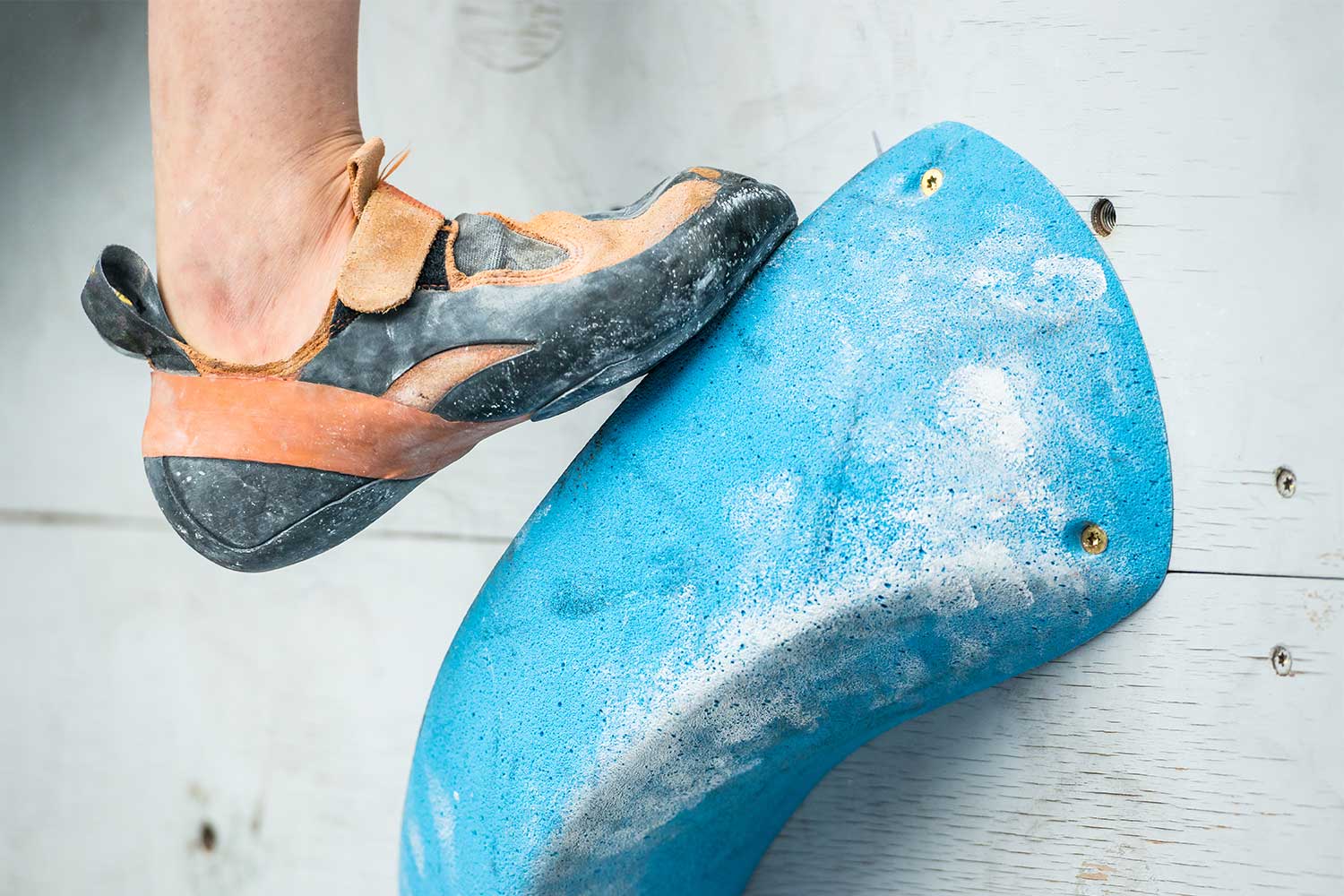
Published on: 03/04/2022
Last updated on: 09/29/2023
Climbing shoes wear down as you use them, especially on rough terrain. The goal of climbing shoe rubber is to stick to the rock, but the rock also wears down the rubber over time. The remainder of the shoe usually stays in reasonably good condition for a more extended period of time, leaving the rubber soles as the only area in need of repair.
This is where resoling comes in. Resoling involves replacing the original sole with new rubber while keeping the other sections of the shoe intact. This article will discuss how to know when it’s time for a resole and then mention a few trusted places that provide these services to get you back out climbing as quickly as possible.
The Importance of Resoling Climbing Shoes
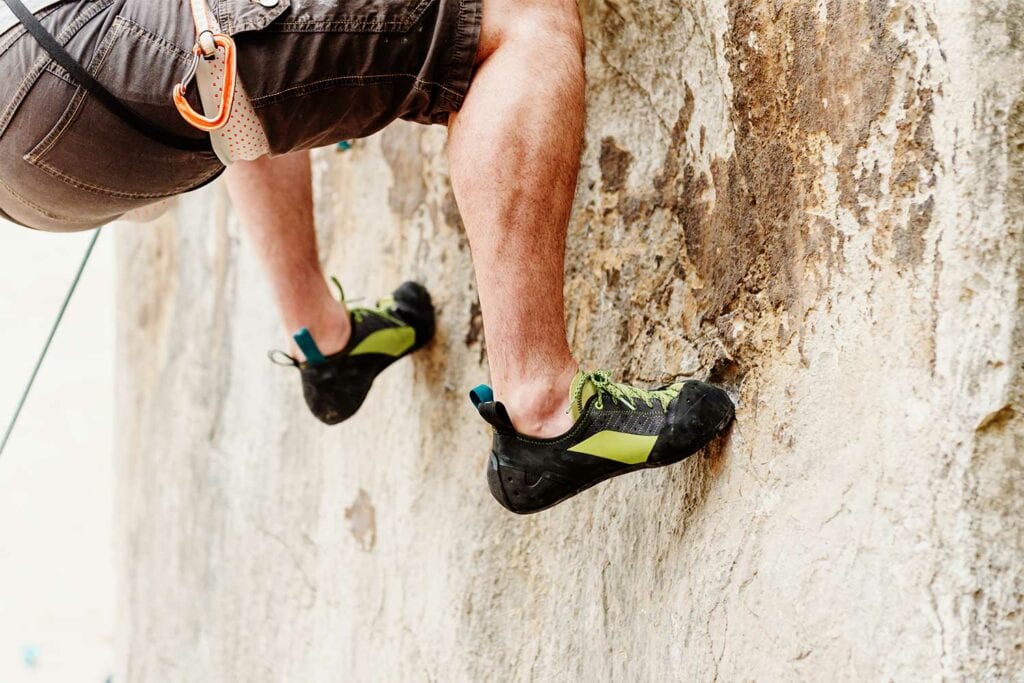
Whether you are an avid climber or climb only on occasion, your worn shoes will reach a point where the rubber starts to weaken. The toe box is one of the most common places you will experience this through thinning and holes. Even with these issues, many climbers will continue to climb without going for a repair, leading to complete deterioration.
Climbing shoes have three main parts – the sole, the rand, and the upper. The sole is the rubber area located around the bottom and sides of the shoe that allows you to better adhere to surfaces. The sole of climbing shoes takes on the most wear and tear.
The rand is a thin layer of rubber that wraps around the shoe’s toes and sides. You can find it between the sole and the upper. The purpose of the rand is to protect the material of the upper. Although the rand rubber is not as exposed as the sole, this area can also develop damage.
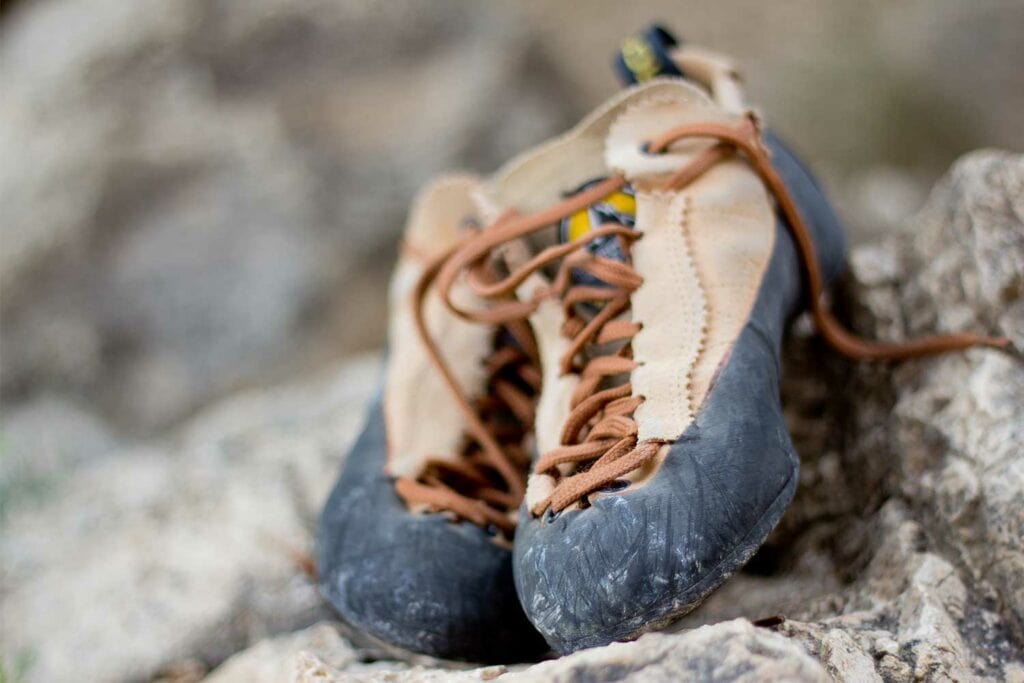
The upper of a climbing shoe is the leather or synthetic material located on the top of the shoe. This piece holds and connects everything together. If there’s significant damage to the upper, the shoe might be beyond repair, and you will need to replace it. Of course, it’s always possible to match minor holes.
If the sole or rand of your climbing shoes becomes thin and worn, stop climbing in them and consider resoling or replacing them if needed. Climbing shoe resoling is generally a cheaper and more sustainable option and requires less time waiting to have usable shoes again.
When to Resole Climbing Shoes
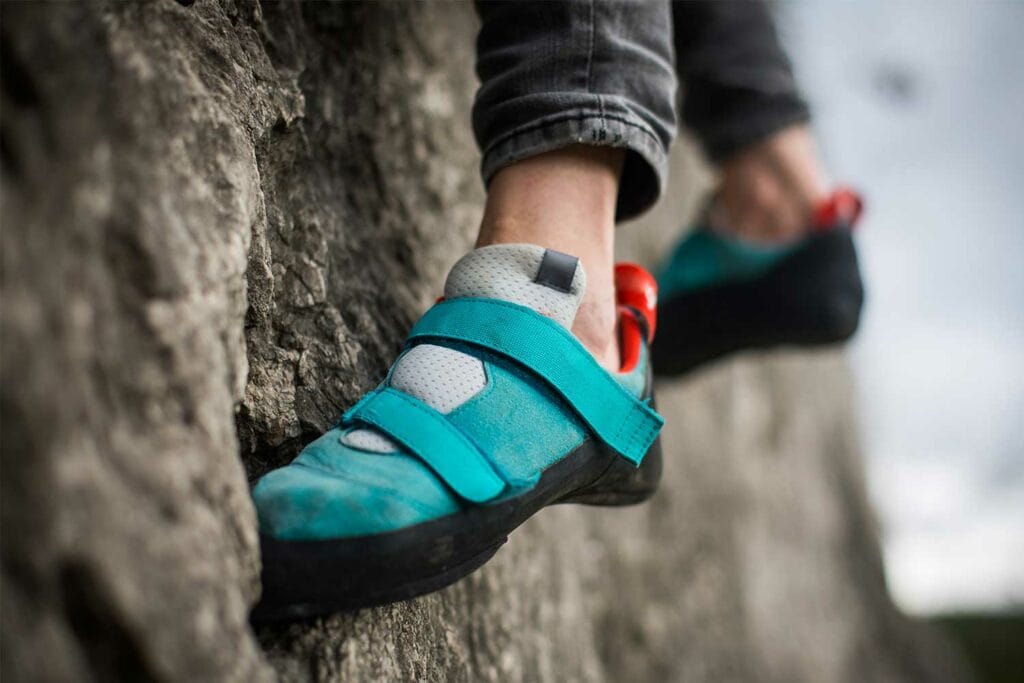
Timing is an essential factor in knowing when you have to resole your shoes. This is not necessary if there is only minimal wear on your shoes. Keep in mind that climbing with any large holes may cause further damage, making it too late for restoration attempts.
The ideal time to resole your climbing shoes is while the rand rubber is still intact, but the area between the sole and rand begins to dip near the big toe. At this point, the rand will still be in good condition and remains firm when pressed.
If you find yourself climbing in a pair of shoes that have worn through the soles completely, the shoe begins to lose performance and will become structurally damaged quickly. At the point that a large hole appears through the sole, rand, or upper material, your climbing shoe is too far gone, and you’ll likely need a brand new pair.
To make sure the rest of the shoe stays in the best condition possible, keep an eye on the seam and resole before the rand becomes wholly worn through. If the rand is damaged, your shoe can still be resolved, but the rand will need to be repaired too, and it will likely cost you much more than a simple resole.
Budget
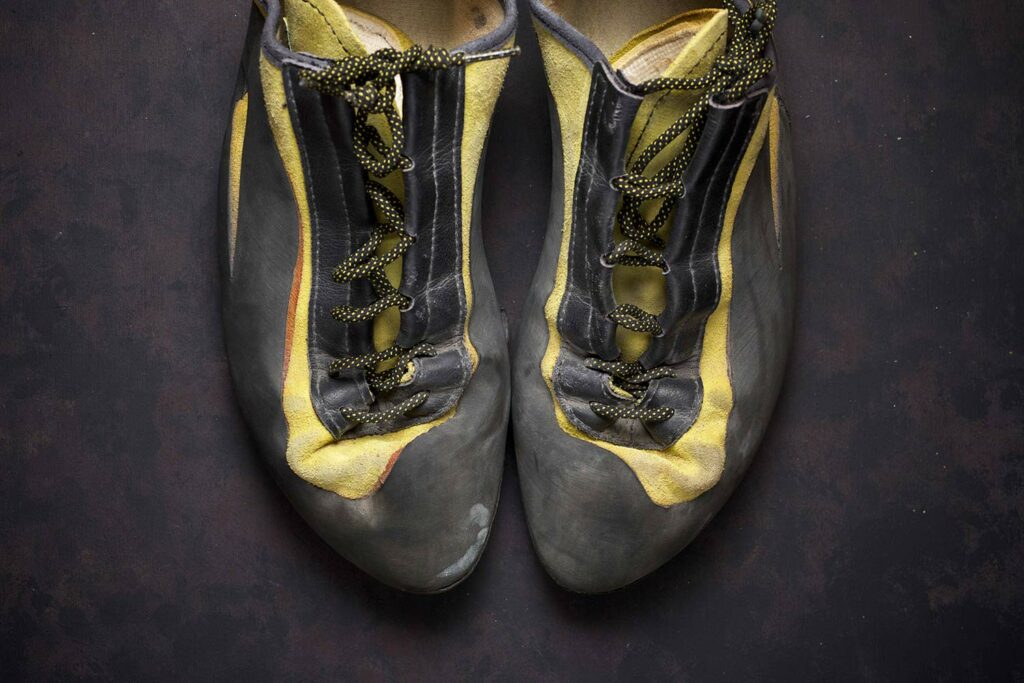
Your climbing shoes are a vital piece of gear but can come at a steep price. Since you’ve already spent a good amount of money finding your pair of shoes, resoling is an excellent way to get more mileage from them and prevent spending time breaking in a stiff new pair.
A standard resole, or a half resole, will cost $30 to $40. Shipping may be a small additional cost if you don’t have a good resoler nearby.
A climbing shoe rand repair will cost you about $20 to $40 on top of the standard resole price. A rand repair mends or replaces the affected rand rubber. The price is usually per shoe.
Also, if you are looking to repair different shoes, like approach shoes, it may cost you slightly more for these services. Either way, a climbing shoe resole is generally more cost-effective and worth the price to continue climbing in your favorite shoes.
Sustainability

Let’s consider sustainability for a second. The more pairs of shoes you own, the more waste you contribute to the world. More shoes can also mean less space in your closet or home. Choosing to resole compared to buying new shoes is just simply eco-friendly.
Resoling Means Not Having to Break in Those New Shoes
Resoling means not having to break in a new pair of shoes! Breaking in shoes is a process that can be both lengthy and stressful. Think about this; you finally start climbing in those beautifully broken-in shoes, and you’re finding your groove. Before you know it, the sole has begun to wear thin, and it looks like you’ve got some decisions to make.
Choosing to resole your shoes helps repair the worn rubber before you have to replace them, keeping your favorite pair of shoes in ideal condition.
How to Resole Rock Climbing Shoes
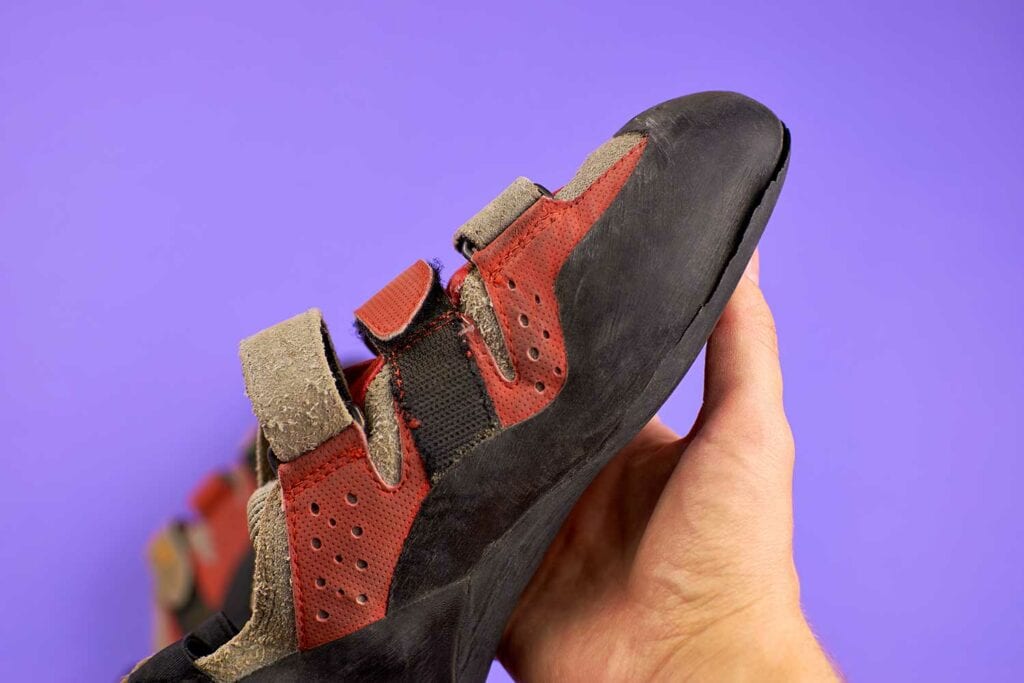
Climbing rubber is known to wear down quickly. How often you climb will determine how often you need to get a rand repair or resole your shoes. Generally, every 3-9 months is an average timeframe for consistent climbers.
Getting your shoes resoled is a process most climbers would instead outsource than do themselves, but the DIY method can also be a good choice.
During resoling, a fresh layer of rubber is placed on the shoe. For a half resole, rubber is placed only on the front half of the shoe or the toe cap. The entire sole is replaced with a new sole for a full resole. The rand can be fixed in pieces during a rand repair, especially if a mend is needed for a single hole or area on the shoe.
Climbing Shoe Rubber
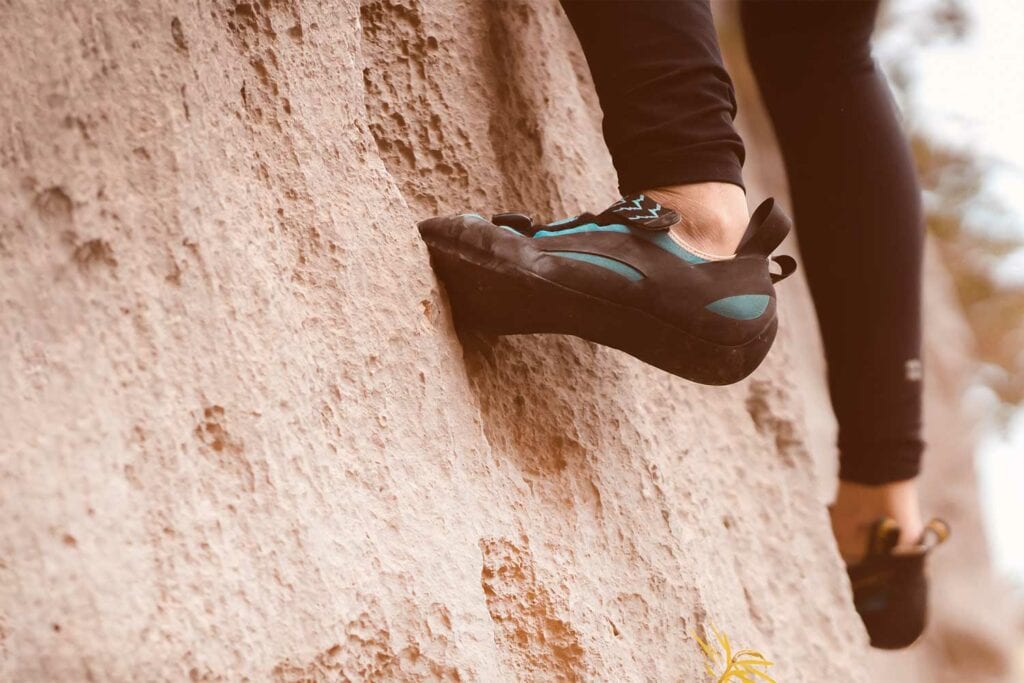
Personal preference comes into play during the process of resoling. You can usually choose a type and specific thickness of rubber for your new sole. The two most common types of climbing rubber are Vibram XS Edge and Stealth C4, although a variety of other types exist.
Softer rubber types are better for smearing and adding friction, but they wear down faster. A stiffer rubber type is more durable but may cause you to sacrifice some flexibility in the shoe. If you’re unsure what rubber type to choose, it’s safest to stick with the original manufacturer’s choice. Also, keep in mind that some shoe resolers may not have a wide variety of rubber available.
When choosing the thickness of the rubber for your shoe – 3mm to 5mm. 4mm is the industry standard and will give you the best performance. The thicker the rubber, the less resoling you will need, but it may cost extra. As a general rule, thicker rubber is the best option for climbing at the gym and using on a beat-up pair of training shoes.
If you climb in a more downturned or aggressive shoe, most resolers can maintain or restore it to its original shape. Edgeless climbing shoes, a newer shoe option by La Sportiva, do not contain a seam but you can still resole them. These shoes are generally resoled with premade replacements made by the manufacturer.
Where to Go

When choosing a trusted place to resole your shoes, think about proximity to you and the quality you want. Well-known companies are more likely to give you quality.
Ask around in your climbing community or check out climbing forums for advice and local companies nearby. If shipping is too expensive, find a trusted resoler within driving distance.
REI does not resole climbing shoes, but here are a few trusted places across the country that are great options:
Rock and Resole (Boulder, CO)
This place has a reputable repair shop and a large in-store selection of climbing shoes for sale. Rock and Resole can resole climbing shoes as well as approach shoes. There is a deposit of $50 for a pair of climbing shoes and $60 for approach shoes. The total price depends on the repairs needed. Resoling a single shoe has an added $5 fee to be paid with the deposit. Through their site, you can create an account, add the number of shoes and rands you want resoled, add toe caps if needed, and then conveniently pay the deposit online.
Yosemite Bum Resoles (Tustin, CA)
It’s the only resoler owned by a shoe manufacturer. Here, your shoes will be resoled by the people who also make the shoes. Yosemite Bum Resoles has a current wait time of 4.5 weeks with an average turnaround time of about 3 weeks. Visit their website to send in an order form and ship directly to them.
The Rubber Room, CA
Located in the Eastern Sierras, they have been resoling climbing shoes for over thirty years. Through their online order form, sending in your shoes for resoling is a quick and easy process. Half soles are $44 a pair with a $12 rand repair price per shoe. The Rubber Room prefers that you send your shoes via USPS Priority and has a current turnaround time of 9-10 weeks.
Pro Deal Resoles in Pueblo, CO
This is a great place for resoling if you’re looking for faster turnaround times and lower costs. A standard resole will cost you $33 for the pair with a $10 rand repair price per shoe. Send your shoes in at any time with your contact information and pay via the order form online. Pro Deal Resoles also allows climbers to email or text a picture of shoes for a quote, so the cost is known beforehand.
Cost
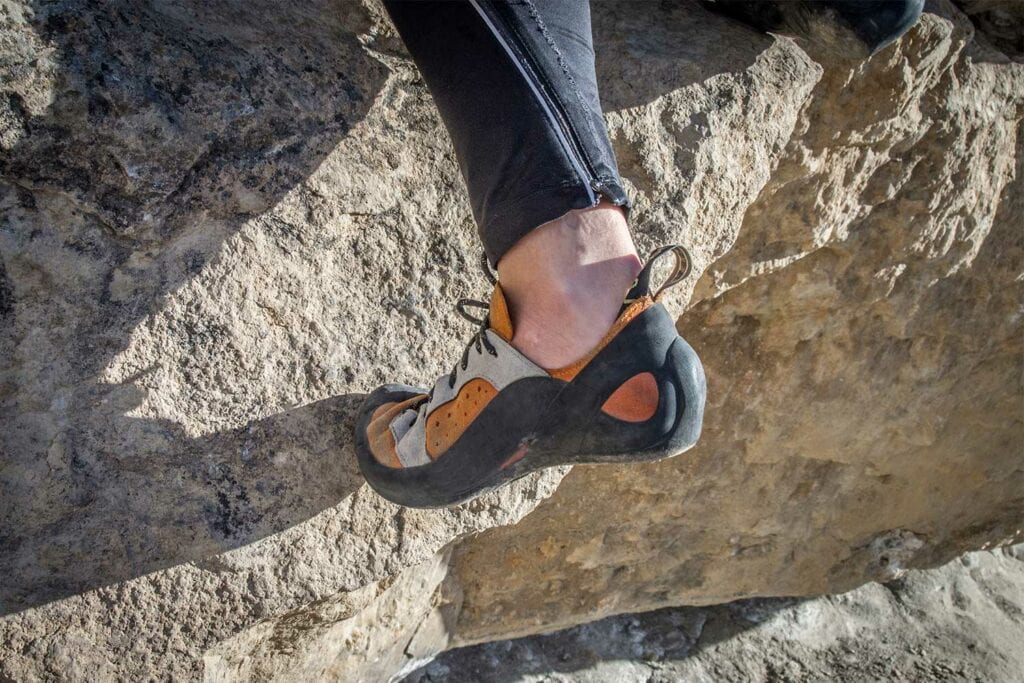
Climbing shoe resoles cost between $40 and $140, including shipping. You’ll likely need to send them in by mail. The more repairs needed, the higher the cost.
A standard resole will cost about $30 to $40 plus shipping costs. $38 is the industry standard price for a half resole. More intense damage may require a rand repair for new toe caps, which will run about $10 per shoe on top of the resole price.
A full resole means that the rubber is replaced on the full soles. Keep in mind that a new fresh sole will be pricier than a half sole and costs about $40-50.
Things to Consider
The resole process generally has turnaround times of two to eight weeks. Climbing has become increasingly popular in recent years, which means there has been an increase in shoe repairs, resulting in a longer waitlist.
It’s best to have a pair of backups or rent other shoes while waiting. Resoling in the off-season will have quicker turnaround times. You may also be able to get your shoes back quicker than expected if you’re willing to spend extra money for express shipping.
Most resolers will give you a better deal on the cost of shipping if you send in multiple pairs at once rather than one pair at a time.

You always have the option to customize the climbing shoe rubber, sole, and rand to your needs. Customizations come at an extra cost but are worth it if you know what you want and need.
If you’d rather spend money on a new pair of shoes or have a pair that you don’t use, consider donating or selling your shoes.
Is Resoling Worth It?
The cost of a new pair of La Sportiva Solutions is about $180. Compared to the price of a new pair of climbing shoes, a $58 resole is a fantastic money-saving option. However, if getting your climbing shoes resoled will cost you upwards of $100, buying a new pair of shoes is likely the better choice.
You may be able to find a pair of lightly used shoes for under $100 if you know where to look. Many resolers sell shoes, including new and used.
Please note: How you care for your shoes determines how long they will last. You should only wear climbing shoes for climbing. It’s better not to walk around or belay in them as this can cause further and unnecessary deterioration. It’s important to air out your shoes to dry any excess moisture. A resole may not fix the smell of your shoes, so be sure to take care of the upper material to keep them in the best shape possible.
What About the Upper?

The upper material is usually made of leather or synthetic materials and is left unaltered after a climbing shoe resole. The shoe resoler intends to leave the upper in the same condition as you gave it to them.
In some cases, the uppers may feel slightly tighter, so you may have to stretch the area before use. Changes in the upper will depend on the resoler. To ensure your shoes come back to you in the best condition, use the service of someone you trust.
If the upper of your shoes has holes, your best bet is to ask your resoler if they can help. They have a vast amount of experience fixing shoes so you can be sure it won’t be the first time they have to deal with it. Alternatively, you can also try to patch the holes with synthetic or rubber patches.
FAQs
Many climbers choose to resole their own shoes. You can purchase resole kits if you’d prefer to do it yourself. It is a slightly cheaper option than outsourcing the resole process. The materials needed include a resole kit, a knife, sandpaper, and pliers.
A climbing shoe can handle about three resoles and one rand repair before losing its shape and effectiveness. If you’re taking great care of your shoes, you may be able to get up to five resoles in total. Resolers will be able to tell you if your shoes are beyond repair. It’s good to note that a DIY resole doesn’t usually hold up as well or as long as getting it done by a professional.
If you have a small hole in the toe or sole of your climbing shoes, a shoe repair kit will work best. Many climbers may use glue, like Shoe Goo, Barge Cement, rubber glue, or even super glue. In this situation, cover both sides of the holes with glue, smooth it out, and then let it dry completely. This is a quick fix and is not meant to be permanent. For longer-lasting mend, get your climbing shoes resoled.
When a hole begins to form in the sole of your shoe and you want a quick fix, glue works great! Super glue isn’t the best option since it takes a very long time to dry, but it can be sufficient if you have nothing else. Rubber glue, contact cement, or vulcanizing rubber glues are better options. Place glue on both sides of the hole and use a putty knife to smooth out the area. Let it dry completely, then peel off any extra product.
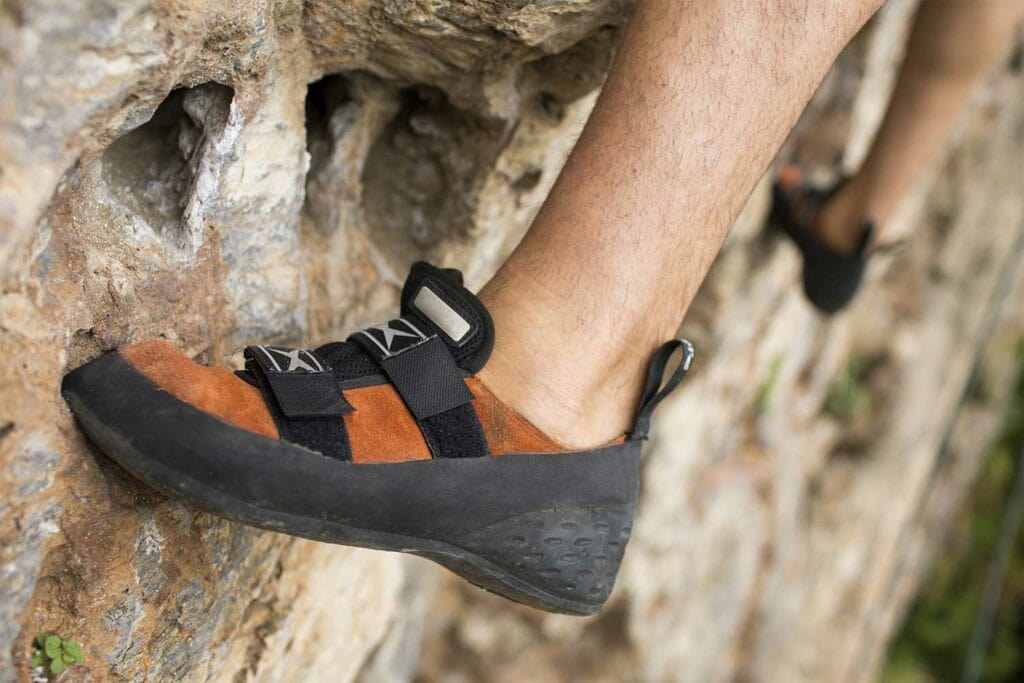
Now that you understand why it is valuable to know when and how to resole climbing shoes, you can do your part in being a responsible and safe climber. Resoling is an important part of maintaining your gear. It will keep your pair of shoes in the best condition possible, without causing further damage to your equipment or your wallet.
